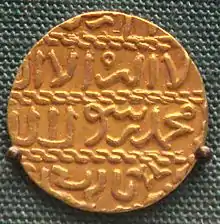Barsbay
Al-Ashraf Sayf ad-Dīn Bārsbay (Arabic: الأشرف سيف الدين برسباي) was the ninth Burji Mamluk sultan of Egypt from AD 1422 to 1438. He was Circassian by birth and a former slave of the first Burji Sultan, Barquq.
| Barsbay | |
|---|---|
 Gold ashrafi of Barsbay (1422-1438). British Museum. | |
| Sultan of Egypt and Syria | |
| Reign | 1422 – 1438 |
| Predecessor | An-Nasir ad-Din Muhammad |
| Successor | Al-Aziz Jamal ad-Din Yusuf |
| Born | c. 1369 |
| Died | 7 June 1438 |
| Spouse | Khawand Fatima Khawand Julban Hund Şehzade Khawand Fatima Khawand Malikbay |
His 16-year reign was relatively long reign by the standards of the Mamluk period in Egypt. His reign was marked by relative security and stability, with few wars or rebellions. He apparently had a reputation simultaneously for being greedy and bad-tempered but also generous to the poor and to Sufis (the latter tendency being evident in his mausoleum-khanqah complex in the Northern Cemetery).[1]
He was responsible for a number of administrative reforms in the Mamluk state, including the consolidation of the sultanate as a military magistrature and securing for Egypt exclusive rights over the Red Sea trade between Yemen and Europe.[2] In the process he diverted the Indian Ocean trade routes through Jeddah (closer to Cairo) and also introduced a state monopoly on sugar and pepper.[3][1] His Red Sea activity included the final destruction in 1426 of ‘Aydhab, a once important port which had been in decline in the previous century.
In 1426-1427 he invaded and reconquered Cyprus, captured its king (from the House of Lusignan) and forced him to pay tribute.[4]
In 1430 Egypt was severely struck by famine and plague.
Barsbay had good ties with other Muslim rulers of his time, namely Jalaluddin Muhammad Shah, the Sultan of Bengal.[5] According to Al-Sakhawi's Al-Daw al-lami` li ahli al-Qarni al-Tasi,[6] the Mamluk sultan once gifted the Bengali sultan with investiture, a robe of honour and a letter of recognition.[7][8] The Bengali ruler had died before his gifts could be dispatched to Barsbay. His son and successor, Shamsuddin Ahmad Shah, had slightly delayed the dispatching but nevertheless sending the initial gifts of his father off whilst also adding more gifts of his own. In total, the package was worth over 12,000 red tankas and included clothes, cotton, ginger, myrobalan and other spices. The envoy, travelling from Bengal to Cairo via the Indian Ocean, sank whilst at Jeddah's coast. In 1436, the Governor of Jeddah sent some men to search the Red Sea for the gifts and they came back with the textiles although the spices were damaged by the water. After Barsbay was informed of this by the governor, he ordered for the arrest of all members of the Bengali embassy, the confiscation of their envoy's merchandise, and banned them from ever travelling to Cairo again.[9]
The revenues from this military victory and these trade policies may have helped him finance his construction projects, and he is known for at least three extant and notable monuments. He built a madrasa-mosque complex in the heart of Cairo on al-Muizz street in 1424. His mausoleum complex, which also included a madrasa and khanqah, was built in Cairo's Northern Cemetery in 1432. He also built a mosque in the town of al-Khanqa, north of Cairo, in 1437.[10][3]
See also
References
- Williams, Caroline (2018). Islamic Monuments in Cairo: The Practical Guide (7th ed.). Cairo: The American University in Cairo Press. pp. 225–226.
- Garcin, 293-94.
- Doris Behren-Abouseif (2007). Cairo of the Mamluks: A History of its Architecture and its Culture. I. B. Tauris & Co Ltd.
- O'Kane, Bernard (2016). The Mosques of Egypt. Cairo: The American University in Cairo Press. pp. 66–70.
- MA Taher (2012). "Jalaluddin Muhammad Shah". In Islam, Sirajul; Miah, Sajahan; Khanam, Mahfuza; Ahmed, Sabbir (eds.). Banglapedia: the National Encyclopedia of Bangladesh (Online ed.). Dhaka, Bangladesh: Banglapedia Trust, Asiatic Society of Bangladesh. ISBN 984-32-0576-6. OCLC 52727562. Retrieved 31 January 2021.
- Abdul Karim (1960). Corpus of the Muslim Coins of Bengal: (down to A. D. 1538). Asiatic Society of Pakistan.
- Al-Sakhawi. Al-Daw al-lami` li ahli al-Qarni al-Tasi (in Arabic).
- ʻAbdallāh Muḥammad Ibn-ʻUmar al-Makkī al-Āṣafī al-Ulughkhānī Hajjī ad-Dabir. Zafar ul wālih bi Muzaffar wa ālihi (in Arabic).
- Behrens-Abouseif, Doris (16 May 2014). Practising Diplomacy in the Mamluk Sultanate: Gifts and Material Culture in the Medieval Islamic World. Bloomsbury Publishing. pp. 9, 29, 46.
- "Barsbay". Grove Encyclopedia of Islamic Art & Architecture. 1. New York City: Oxford University Press. 2009.
Sources
- D. Behrens-Abouseif, Islamic architecture in Cairo: an introduction (Leiden, 1989).
- J.-C. Garcin, "The regime of the Circassian Mamluks," in C. Petry, ed., The Cambridge History of Egypt, Volume I: Islamic Egypt, 640-1517 (Cambridge, 1998), 290-317.
- Muir, W. (1896). The Mameluke; or, Slave dynasty of Egypt, 1260-1517, A. D. Smith, Elder. pp. 137−148.
| Regnal titles | ||
|---|---|---|
| Preceded by An-Nasir ad-Din Muhammad |
Mamluk Sultan of Egypt 1422–1438 |
Succeeded by Al-Aziz Jamal ad-Din Yusuf |